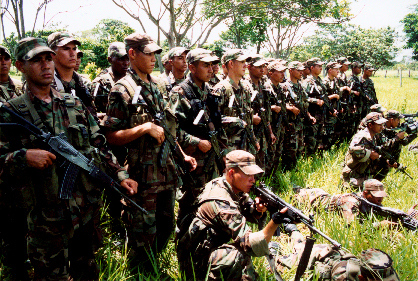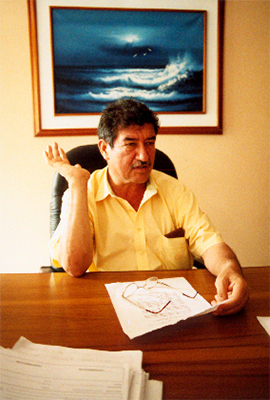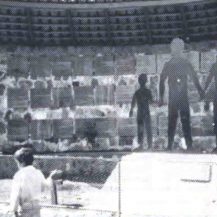The Massacre at Betoyes
An armed group attacked the indigenous Guahibo community at Betoyes. Who was it?
This text originally published: 4 August 2003

The turmoil that rural Colombian communities experience on a daily basis is exemplified by a recent incident at the indigenous reserve of Betoyes, composed of a number of small hamlets near Tame, in the southwest corner of the eastern Arauca department. In early May this year, an armed group attacked the indigenous Guahibo community at Betoyes. Three Guahibo girls, ages 11, 12, and 15, were raped by the assailants. A pregnant 16-year-old, Omaira Fernández, was also raped, and then the attackers reportedly cut her womb open to pull out the fetus, which they hacked apart with machetes, before dumping her body and the fetus in a river. That same day, three indigenous men were shot and disappeared. Some 327 of the remaining Guahibos fled the reserve for Saravena, a town in the northwest corner of the Arauca department. Once there, the Guahibos took up residence in an abandoned school, protesting their displacement by occupying a church.
Who attacked, raped, murdered, and displaced these Guahibos? Almost all accounts point toward soldiers from the Colombian army’s 18th Brigade and its Navos Pardo Battalion perhaps working in conjunction with the paramilitaries. On May 14, the Regional Indigenous Council of Arauca (CRIA), a departmental indigenous organization affiliated with the National Indigenous Organization of Colombia (ONIC), reported that a number of survivors from the Betoyes massacre identified the attackers as army troops wearing paramilitary armbands. The Joel Sierra Committee, an Arauca human rights group, echoed these claims in a press release on May 14 signed by a number of regional NGOs.
In a June 4 release, Amnesty International (AI) reported that army helicopters had strafed and bombarded a number of the hamlets that make up the Betoyes reserve during a late-April skirmish with guerrillas; their sources also indicated that the choppers had ferried in army troops as well as paramilitary fighters. Then, on May 1, according to AI, soldiers from the 18th Brigade entered a number of Betoyes hamlets wearing armbands from the United Self-Defense Forces of Colombia (AUC) and the Self-Defense Forces of Casanare (ACC), a splinter paramilitary group that has refused to participate in the AUC’s negotiations with the government. During a similar attack by a group of armed men in Betoyes in January 2003, witnesses said that the AUC armband of one attacker slipped to reveal the words “Navos Pardo Battalion” printed on the uniform beneath.
Evidence that the attack was carried out by paramilitaries acting alone is hard to come by. Reporting from Saravena, Reuters correspondent Jason Webb interviewed a survivor of the May attack on Betoyes who said, “The paramilitaries told us if we didn’t leave town, they would make us kneel down, massacre us, and rape us.” But considering the plethora of reports alleging the army’s use of AUC armbands as disguises, this witness’s account does not exclude the possibility that the attackers were members of the Colombian armed forces.
According to Darío Tulibila, president of the CRIA, during the May incursion, a number of the attackers wearing AUC armbands were identified by villagers as known members of the Colombian army—witnesses could even provide their names: Eran Alfonso Ríos Monterrey, Lisandro Camargo Acevedo, Diego Muñoz Usquiana, etcetera. Tulibila does not shy away from assigning the blame for the Betoyes massacre: “It wasn’t the paramilitaries, it was the army. The army itself is creating the disorder.”
The army has a different stance entirely. “It’s a disgrace to declare that what the terrorists have done was actually the army disguised as terrorists. It’s easy if you’re not here to echo such slanders… They are lies, not by Amnesty International, but by those who told them to Amnesty International. Amnesty International can’t come corroborate them in the field,” says an obviously perturbed Colonel Cruz, Commander of the army’s 5th Mobile Brigade stationed at the Navos Pardo Battalion base. His version of the events sums up the army’s position: The paramilitaries arrived in the Betoyes in mid-April and confronted the FARC and ELN squadrons stationed there. In order to remove the armed groups from the area, the Navos Pardo Battalion then mounted Operation Colosso, “which had excellent results.”
The nation’s leading newspaper, Bogotá daily El Tiempo, mostly parroted the army line, saying in a May 15 article that the displacement occurred as a result of paramilitary confrontations with guerrillas in the area, and that civilian deaths had occurred in the “crossfire” between the groups. However, Col. Cruz is even more focused in his account of the incident: “The terrorist groups of the FARC and the ELN forced, for some weeks now, a massive displacement of indigenous people and peasants from the area of Betoyes, where there are various indigenous reserves, and obliged them to move into some very difficult, subhuman conditions in the city of Saravena.” He says the army’s 18th Brigade and his 5th Mobile Brigade are now working jointly to secure Betoyes so that the displaced Guahibos can return to their lands.

Tame Mayor Jorge Bernal holding a fax from the FARC naming him as a 'narcoparamilitary'. Photo: Eric Fichtl
But the available evidence seems to contradict the official version of the events. The most striking hole in the army’s line is that the Guahibos, allegedly displaced by the guerrillas, fled to Saravena, the most guerrilla-controlled town in all of Arauca. This was hardly the place to go to avoid their purported attackers. According to the Tame Mayor Jorge Bernal, in the immediate aftermath of the Betoyes massacre, some of the displaced Guahibos arrived in his town seeking refuge, but quickly dislodged to Saravena because, “they said that in Tame they didn’t have sufficient guarantees. I offered them support so that they could stay in Tame, but they decided to go to Saravena and left.” It is illuminating to note that the Guahibos felt that their safety could not be guaranteed in Tame, home to a massive army and police security force and the largest paramilitary presence in Arauca, and that they felt guerrilla-dominated Saravena, hours away through heavily contested territory, was a safer place to seek refuge.
It is worthwhile noting, too, the comments of Colonel Montoya Sánchez of the 18th Brigade, who said that both the Guahibos occupying the Saravena church and some other recently displaced peasants were following “ELN orientations.” That claim was vigorously denounced by the ONIC to Colombian Defense Minister Martha Lucía Ramírez: “[The colonel’s statement had] the evident goal of delegitimizing the demands of the displaced and automatically converting them into military targets.” The ONIC’s denunciation went on to contradict Col. Montoya Sánchez’s claims that the CRIA was being manipulated by the Joel Sierra Committee, a human rights NGO that military and public officials in Arauca often accuse of being a guerrilla front.
Such accusations and smear campaigns fly freely in Colombia’s dirty war. During our interview with Tame’s Mayor Jorge Bernal, a fax arrived from the FARC’s Alfonso Castellanos Mobile Column denouncing him and a number of local officials as “narcoparamilitaries” that had “infiltrated a poor town that only seeks to live in a dignified manner.” A few moments later when my colleague and I asked if the mayor’s office was in contact with the regional Joel Sierra Human Rights Committee, the deputy mayor snapped, “This [FARC fax] is from them, this is from an illegal group, from the FARC-ELN—that’s the ‘human rights group.’”
Without specifying which groups he refers to, Captain Paredes of the army’s 18th Brigade reiterates this type of charge: “Here in Arauca we have social organizations that we invited to inspect the order, to question or criticize the public forces when there are errors… But these social organizations have already demonstrated that they are not looking for order, but rather disorder. And in one way or another, they are at the service of the insurgent groups… They make irresponsible denunciations where they brand the brigade commander as if he were a paramilitary… They keep saying that we work in conjunction with the paramilitaries, that we form a single team, and this is a big lie.”

These Guahibos were displaced from their indigenous reserve at Betoyes in early May 2003. They fled to Saravena. Photo by Jason Howe
The war raging in the Araucan countryside makes independent verification of the facts very difficult. For their part, local officials cannot get out of Tame to the rural sector to investigate crimes. After receiving death threats from the armed groups, all of Tame’s journalists fled to Bogotá, leaving the municipality with no resident press to cover the daily carnage and investigate rights abuses. The army’s radio station is the only one most tameños can tune in. At this point, uncovering the perpetrators of the assault on the indigenous community at Betoyes cannot be an exact science. And yet aside from the testimony of the survivors of the attack, who accuse the Colombian army itself, perhaps the clearest evidence we have for determining who was responsible for the massacre at Betoyes is the fact that the Guahibo community did not feel safe in Tame, a virtual military garrison with a significant paramilitary presence, and instead chose to make for guerrilla-controlled Saravena, the town with the weakest state authority in Arauca.
What is certain is that the displaced Guahibos are frightened and reluctant to return to Betoyes, despite the army’s claims that it is securing the area for them. Jason Howe, a freelance photographer who traveled to Saravena in June, recounts a morning encounter he and a colleague had with some of the displaced Guahibos who were washing their clothes on a riverbank: “Their desperate flight from their homes had left them exhausted and frightened. Slowly, we moved towards them crouching in order to appear less of a threat, smiling until our faces hurt. Eight-year-old girls dressed in tattered dresses hugged naked, crying babies closer to the chests, eyes darting around trying to assess the danger. Our smiles were not returned; clothes and dirty children were hurriedly scrubbed. Wet clothes were stuffed into bags, the tiny babies strapped onto their mothers’ backs and without a backwards glance the refugees climbed the steep riverbank and returned to the smoky, filthy camps into which we were not allowed to follow.”
Notes
This article has been extracted from Eric Fichtl’s special report for Colombia Journal, “Araucan Nightmare: Life and Death in Tame”.
Eric Fichtl traveled to Tame, Arauca in June 2003.
This article originally appeared in Colombia Journal, an online journal that was published by the Information Network of the Americas (INOTA).


